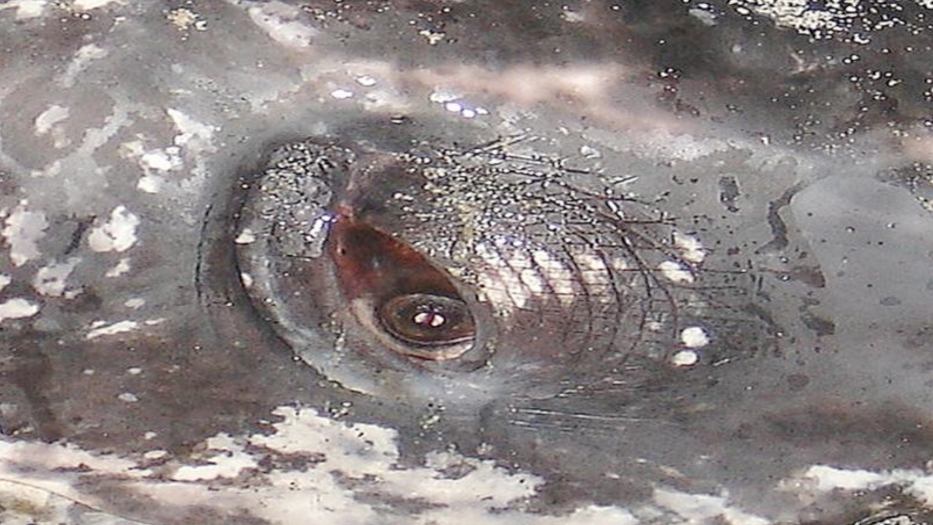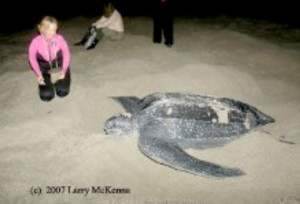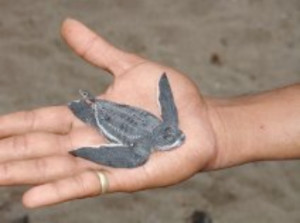Marine Life & Conservation
Saving Leatherback Turtles

Last summer I was sat on the cliffs at Pendeen in Cornwall watching the sea swell gently rise and fall over the rocks below. It was a still and bright sunny day with Fulmars circling along the cliff face and the occasional seal checking out the shallows for food. Just as I was thinking how it couldn’t get any better, nature did its thing and sent a giant Leatherback Turtle cruising 100meters out from the shore. It really was a giant too. Hard to guess its real size but it had to be at least 5-6ft long.
The leatherback is the largest of the marine turtles and gets its name from the black, leathery skin that covers its carapace. Leatherback turtles are considered to be critically endangered by the International Union for the Conservation of Nature (IUCN). Nesting females are often killed for their meat and their eggs are harvested. At sea leatherbacks seem to be particularly vulnerable to entanglement in fishing gear, especially long lines and gill nets.
It’s hard to describe how I felt watching this fantastic animal swimming to some unknown part of the ocean. I know I was smiling. It is hard to accept that one day soon, that turtle, along with its entire species, may be gone from this planet forever, never to return.
Larry McKenna is the founding director of S.O.L.O. (Save Our Leatherbacks Operation). I first heard of his work through MilaBooks.com and their Sea-Gram News Letter. The following is taken from the April edition of the Sea-Gram news letter.
Larry McKenna’s work takes him to the remote land of Papua, Indonesia, home to the Aboriginal Papauans, and site of the largest leatherback sea turtle nesting beach, about 18 kilometers long and up to 100 meters wide.
Larry describes the scene on the beach:
“The only illumination is a reflection of moon light on the white foam of a breaking wave. All is quiet, except the gentle lapping of the surf while we wait for a living dinosaur to exit the sea and laboriously climb the slope of the beach.
She will locate where she was hatched 12 or more years ago, repeating the 150-million-year drive to reproduce so the species may survive. Left alone, this ancient hatching process would continue unimpeded, but humans have introduced the spectre of extinction of this most valuable creature of the seas.”
When the leatherback selects her nesting spot and begins to dig a four-foot-deep nest, she goes into a trance and does not recognize any activity. Enlightened humans can approach and marvel at the amazing beauty nature provides.
However, while she is in this egg-laying trance, the nesting female is in danger from other humans; those who would slit her throat and use her skin for handbags and fashion items, in addition to senseless killings, egg poaching, and trophy collecting.
Global warming poses another threat, as high tides drown nests and heat cooks the eggs in their shells.
Leatherback hatchlings are about four inches long and cannot crawl over a twig. Yet they must face a host of jungle predators at nesting beaches, such as wild pigs, dogs, salt water crocodiles, crabs, and pythons.
Larry’s activities include relocating eggs from tidal nests into bamboo pens, and excavating the nests that hatched in the night to examine the remains and determine what happened to unhatched eggs.
In almost every nest he finds several comatose hatchlings, which ran out of air climbing upward to freedom. He places an unconscious hatchling in the palm of a guest’s hand and encourage him/her to give it “leatherback CPR” by softly blowing into its face and nose. Soon it begins to wiggle and wants to be set on the sand. All the volunteers have tears in their eyes because they have just given life to a leatherback baby which would have become crab food later in the day.
How you can help:
1. Should you wish to experience this truly exciting and memorable visit to the leatherbacks, along with some of the best diving in the world, please contact P.J. Campagna, a very dedicated foundation volunteer, for the details:
2. Watch this short youtube video (which includes donation information), placing you right there on the nesting beach, but which also shows some of the ATROCITIES humans inflict on these gentle giants:
[youtube id=”ufD8jJgK2p4″ width=”100%” height=”400px”]
The above text, information, and photos are used with permission, from Larry’s article: To Touch A Dinosaur.
Marine Life & Conservation
Paul Watson Released as Denmark Blocks Japan’s Extradition Bid

Renowned anti-whaling activist Paul Watson has been released from custody in Greenland after spending five months in detention. Denmark’s Justice Ministry rejected Japan’s request for his extradition, citing insufficient guarantees that his time already served in custody would be credited against any potential sentence.
The 74-year-old Canadian-American was arrested on July 21 in Nuuk, Greenland’s capital, when his ship docked to refuel. His arrest was based on a 2012 Japanese warrant related to a 2010 encounter in Antarctic waters. Japan alleged Watson obstructed operations and caused damage to a whaling research ship during efforts to disrupt illegal whaling. Watson has consistently denied these claims, maintaining his commitment to marine conservation.
Denmark, which oversees extradition matters for Greenland, concluded that while the legal conditions for extradition were met, the lack of assurances from Japan regarding time-served credit made extradition untenable.
In a video shared by his foundation, Watson expressed gratitude and relief, saying, “After five months, it’s good to be out… and good to know they’re not sending me to Japan.” He added that the most difficult part of his time in custody was being separated from his two young sons.
Watson is a pioneering figure in marine conservation, known for founding the Captain Paul Watson Foundation in 2022 after decades of activism with the Sea Shepherd Conservation Society. His bold efforts to defend marine life have earned him widespread support, including from celebrities and conservationists. His work has also been featured in the acclaimed reality TV series Whale Wars.
Watson’s lawyer, Jonas Christoffersen, praised the decision, stating, “We are happy and relieved that Paul Watson is now free.” He added that Watson is eager to reunite with his family and continue his vital work.
The arrest occurred while Watson’s vessel, the M/Y John Paul DeJoria, was en route to the North Pacific with a team of 26 volunteers to intercept a Japanese whaling ship. His foundation described the arrest as politically motivated and emphasized that Watson’s actions were focused on ending illegal whaling practices.
Japan resumed commercial whaling in 2019 after leaving the International Whaling Commission, asserting that whale meat is a cultural tradition. Conservationists, however, continue to challenge these practices, highlighting their impact on marine ecosystems.
Despite the challenges, Watson remains steadfast in his mission to protect marine life and bring attention to whaling practices. His dedication to ocean conservation has made him a globally respected advocate for the environment.
Marine Life & Conservation
12 Days of Zero-Waste Fish-mas

This holiday period, the Marine Conservation Society, the UK’s leading ocean membership charity, invites you to make some simple changes to eating fish this Christmas to help our seas.
Dr Kenneth Bodles, Head of Fisheries and Aquaculture at the Marine Conservation Society, said, “During the festive season, our consumption increases, but so does waste. Sustainability isn’t just about where food comes from – it’s also about how you use it. By reducing waste and making the most out of your seafood, you’re not only taking steps to be more ocean-friendly, but can also help to cut costs during what is often one of the most expensive times of the year”.
The Marine Conservation Society has compiled twelve tips on how to consume seafood sustainably with zero-waste this Christmas:
Buy whole fish instead of fillets
Instead of fillets, consider buying whole fish such as salmon, hake, or lemon sole. By adopting a “nose to tail” approach with cooking, whole-baked fish not only feeds a crowd, but also helps to minimise waste and maximise sustainability by using up every part of the animal, including bones, skin, and fat.
Make fish stock
Leftover fish bones or shells can be put to good use by boiling them to make a nourishing fish stock or bisque. This can be frozen and preserved for later use and makes for a flavourful base in a soup.
Make your own fish pâté
Avoid waste by turning leftover fish, such as smoked mackerel or salmon, into a delicious pâté by blending with cream cheese and lemon. Perfect when paired with crackers.
The sustainability of salmon and mackerel varies depending on where and how it is caught or farmed. For more information on green-rated options, check the charity’s Good Fish Guide.
Buy frozen
By purchasing seafood that is frozen or vacuum-packed, this helps to reduce waste by extending the shelf life of your food.
Fish pie
If you’re wondering what to do with leftover cooked fish, why not opt for a classic fish pie with mashed potatoes, leeks, and a cheesy sauce? A sure crowd pleaser on Boxing Day.
Use the head
Don’t forget the fish head! The meat is incredibly tender and flavourful. The charity recommends a cod’s head curry or recreating Fallow’s renowned cod’s head in siracha butter.
By stretching your ingredients further, not only is this a more sustainable way to enjoy seafood, but also cost-effective by repurposing leftovers and cooking creatively.
Boxing Day brunch
Mix leftover kippers or smoked salmon with scrambled eggs for a tasty, zero-waste, Boxing Day brunch.
For best choice, make sure you buy kippers, or herring, from the North Sea and the North Irish Sea.
Zero-waste storage
A top tip from the Marine Conservation Society to avoid waste is freezing fish offcuts to save for future use.
Crisp up the skin
Even leftover fish skin can be turned into a quick savoury snack by crisping it up in an air fryer with a little olive oil and salt.
Anchovies two ways
Leftover anchovies can either be blended with butter to make a delicious anchovy butter or tossed into pasta for a hit of umami flavour.
The charity recommends opting for anchovies caught in the Bay of Biscay for best choice.
Fishcakes
For an easy, zero-waste meal, leftover seafood trimmings can be mixed with mash and fried in breadcrumbs to make fishcakes.
Pickled mussels
Try pickling mussels in 1:1 vinegar and water, with a dash of sugar for a sustainable, zero-waste snack that can be enjoyed well beyond the festive season.
Mussels farmed in the UK are a seafood superhero. Grown using low-impact methods and harvested by hand, they get all the food they need from the sea around them. This makes them one of the most sustainable, ocean-friendly, and cost-effective seafood options.
Players of People’s Postcode Lottery have raised £6.6M towards the Marine Conservation Society’s vital work in making seafood more sustainable.
Laura Chow, Head of Charities at People’s Postcode Lottery, said: “Fish is a festive favourite for many, but making sustainable choices when it comes to how we buy and eat seafood makes all the difference for our ocean. Support from players of People’s Postcode Lottery has helped the Marine Conservation Society further its sustainable seafood work, so that we can all enjoy healthier, better protected seas.”
The Marine Conservation Society encourages you to make sustainable seafood choices a year-round habit, not just for Christmas. To check how sustainable the seafood on your plate is, you can visit the charity’s Good Fish Guide. The Guide helps consumers and businesses identify the most sustainable seafood using a simple traffic light system, based on where and how species are caught or farmed. Green is the best choice, amber means improvements are needed, and red indicates fish to avoid buying.
Zero-waste gift idea
Why not embrace a zero-waste Christmas by gifting a membership to support marine conservation? It’s a meaningful, low-waste gift that helps protect our ocean for generations to come. Memberships start from as little as £5 a month – the price of a sandwich and drink from your local coffee shop.
Find the latest sustainable seafood advice for wild-caught and farmed seafood on the Good Fish Guide, downloadable to your phone from www.mcsuk.org/goodfishguide.
-

 News2 months ago
News2 months agoIconic SS United States to become the World’s Largest Artificial Reef
-

 News3 months ago
News3 months agoBook Review – 52 Assignments: Underwater Photography
-

 Gear News3 months ago
Gear News3 months agoDYNAMICNORD – New German diving brand enters the British market
-

 News3 months ago
News3 months agoExploring Cenote El Pit: A Diver’s Dream
-

 Gear News3 months ago
Gear News3 months agoTry BARE drysuits (and maybe even win one!) this Friday with Sea & Sea at North West Dive Fest
-

 Marine Life & Conservation3 months ago
Marine Life & Conservation3 months agoBook Review: Coral Triangle Cameos
-

 Blogs2 months ago
Blogs2 months agoDive the Egyptian Red Sea this Autumn with Regaldive
-

 News3 months ago
News3 months ago2024 Ocean Art Underwater Photo Competition Announced





